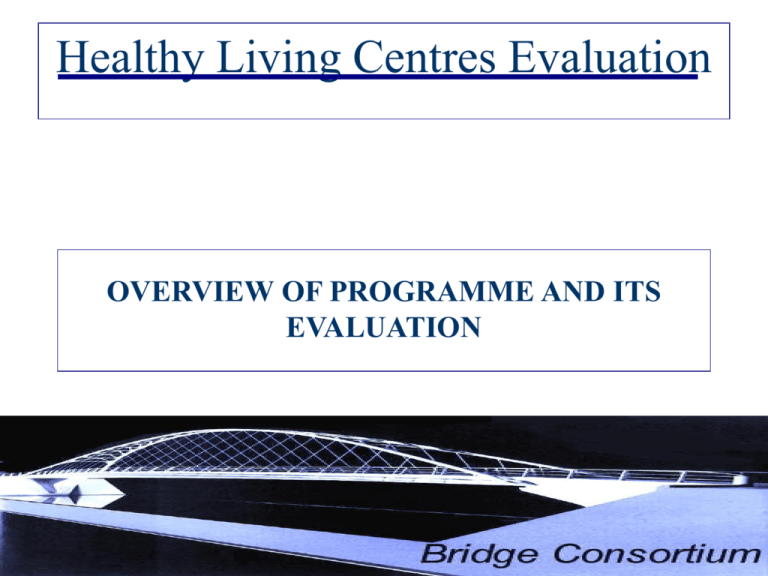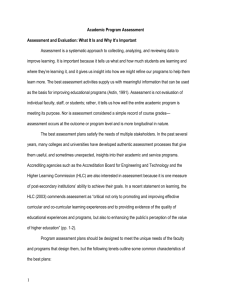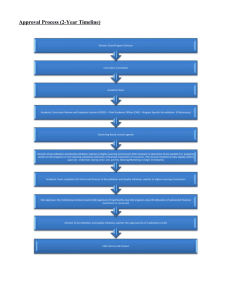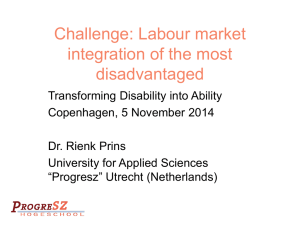Healthy Living Centres Evaluation
advertisement

Healthy Living Centres Evaluation OVERVIEW OF PROGRAMME AND ITS EVALUATION The HLC Programme A large and diverse programme: £300 million, started 1999, final grant awarded 2002 Most projects funded for 3-5 years Final project ends 2009. 350 projects: • 257 in England • 46 in Scotland • 28 in Wales • 19 in Northern Ireland Integral to health policy • Healthy living centres heralded as: 'local flagships for health in the community, reaching out to people who have until now been excluded from opportunities for better health and being powerful catalyses for change in their neighbourhoods'…… (Our Healthier Nation, a Contract for Health, DoH 1997) Evaluation: the challenge • Size and diversity of the programme • The nature of community based health projects – broad aims, complex organisations, flexible and responsive programmes • Multiple programmes and initiatives taking place in HLC areas • Difficulties in measuring outcomes – particularly in short term • Several different evaluations taking place: Programme evaluation, National evaluations in England, Scotland and Wales, local evaluation • Other demands for provision of information: Annual Monitoring Reports, Development and support programme surveys The Bridge Consortium • The Tavistock Institute • University of Edinburgh • Cardiff University • Lancaster University • The Institute of Public Health in Ireland, Belfast • London School of Economics • Glasgow University Evaluation Objectives • to evaluate HLC programme success in terms of the aims of NOF and Healthy Living Centres themselves; • to contribute to the evidence-base regarding the successful strategies to improve health and reduce health inequalities; • to assist HLCs and their partners to learn from overall programme experience in order to develop their capacity and improve their practice; and • to help NOF with the management and development of the programme as well as with future programme and policy development Main Activities of the Evaluation • • • • • • Health Monitoring System: survey of HLC users 40 case studies Policy analysis Workshops with HLCs and local evaluators Survey of all centres (2006) Use of information from parallel evaluations: – Database of intentions and baseline info on all HLCs (DoH evaluation) – Annual monitoring data – Data from development and support activities – Local evaluations Common elements within HLCs • Broad based approach to health – to improve ‘health and wellbeing’ and address wider determinants to health • Aim to promote innovation and responsiveness to local situation • Targeting of disadvantaged areas and groups • Intention to reflect and complement national and local public health plans and priorities • Partnership working • Community engagement • Sustainability Key variations in programme delivery • Lead agency: NHS 24%, LA 23%, partnerships 10%, vol and community sector 33% • General ‘vision of health’: whether targeting life style, service development, community capacity building or wider health determinants (poverty, unemployment etc. • Structure: whether a physical centre, a network or ‘hub and spoke’ model • Focus: whether a geographical neighbourhood, a particular group (older or young people, ethnic group) or particular issue (mental health, physical exercise, diet and nutrition). • Level of involvement with statutory sector (NHS, local authority) • Approach to community involvement Locally identified theory of change cluster Health inequalities cluster 1. Focus on specific health issues A behavioural explanation 2. Lack of access to information 3. Lack of interest and confidence A service accessibility explanation 4. Lack of uptake of conventional services A service appropriateness explanation 5. Social isolation and social exclusion A social exclusion/social capital explanation A community participation/involvement explanation 6. Underlying poverty and unemployment A poverty and income explanation An environmental explanation Most activities run by one organisation Activities all in one location [SR1] Most activities run by one organisation on one site Multiple partners running activities on one site Activities run by number of partners Most activities run by one organisation on number of sites Multiple partners operating activities on a number of sites Activities in multiple locations Wide range of HLC activities • Addressing health behaviour: e.g. health information and advice, physical activities, healthy eating activities, stop smoking projects • Addressing lack of services: health care and screening, support and counselling, services for children and families, older and disabled people • Social activities (addressing social isolation and social exclusion) • Addressing poverty and unemployment (training, work experience, credit unions, benefits advice) Activities embedded in broad approach • Broad programmes of HLCs often include: – social opportunities and emotional support, activities to encourage self help and mutual support – Activities to address some of the causes of poverty - poor literacy skills, and lack of information about benefits and services which might provide assistance. – Engagement of individuals in the work of the centre through consultation structure, volunteering, joining the staff, or developing and running groups and activities of their own. – Building close working relationships with other local groups and organisations, including local statutory sector. A broad approach to tackling health and health inequalities • HLCs successful in targeting sections of the community with high levels of need (HMS data) • Successful in generating programmes of activities at a local level: often large and varied. • Broad health agenda provides flexibility for adjusting programmes to meet local needs, and developing activities that encourage access and engagement • However, activities alone insufficient to engage some sections of the community, particularly where other factors (social isolation, poverty, lack of other services) remain a major obstacle to health and wellbeing. Interim findings on HMS survey • • • • Longitudinal survey delivered via 154 HLCs 4500 returned initial questionnaires 987 returned 18 month follow up questionnaires Analysis of physical and mental functioning and self assessment of health and wellbeing • Useful comparison between regular (monthly) and non regular users • Regular user health remaining stable while ‘non regular user’ health declines • Indicates ‘protective’ effect of HLCs Participants in activities • 75% of service users are women • 44% are aged 55 and over - and 34% are retired • 11% of respondents are from Black and ethnic minority groups • 23% are employed, 6% are unemployed • 11% are permanently unable to work due to illness or disability • 24% of respondents hold educational qualifications at degree level or above • 43% have no car, 8% have no phone, 9% have no central heating Health and wellbeing • 69% say that their health is ‘good’, ‘very good’ or ‘excellent’ • 40% say that they are limited to some extent in moderate activities such as moving a table or pushing a vacuum cleaner • 34% of respondents say that physical health or emotional problems affect their social activities some, most or all of the time • 35% had done some physical activity (e.g. walking, swimming) on sixteen or more days of the previous month Changes in health status at 18 months • Overall decline in SF36 score on mental health (46.645.3) for non regular users, less for regular users (49.7-49.1) • Decline in SF36 score on physical health for non regular users (46.1- 44.9), less for regular users (45.245.1) • General health rating in 21% non regular users changed from good to poor health compared to 10% regular users • General health rating in of 26% non regular users changed from poor to good, compared to 33% regular users • Results sig. even when age, sex taken into account Changes in health behaviour • 24% of regular users quit smoking compared to 19% non regular users – numbers of regulars returning to smoking also lower • 25% of regulars had increased consumption of fruit and vegetables compared to 17% non regular • Less significant results on exercise and drinking behaviour althoug • 24% of non regular increased, and then reduced intensity of exercise compared to 17% regular users The Changing policy context • Initial policy context: Our Healthier Nation and Saving Lives Since then: • Changes in structure and roles of Local Authorities and NHS (LSPs, PCTs) • Less interest in area based interventions • New public health policy: Wanless II and Choosing Health White Paper (new priority areas) • New policy relating to voluntary and community sector, civil engagement and community capacity building. (ODPM, Home Office Civil Renewal Unit) Relevance of programme to current policy debates • Much learning relevant to the delivery of the ‘fully engaged’ scenario of Wanless, and the implementation of the ‘Choosing health’ agenda. • Learning about the skills, experience and resources required to develop local, embedded, projects • Provide evidence of value of a broad health agenda in enabling projects to respond to changes in community, local services and wider policy agendas • Their work at a community level can also contribute to policy debates around the need for better infrastructure for ‘community capacity building’. Current concerns • Sustainability: future funding for most centres uncertain although some activities likely to be taken up by partners. • Some centres looking to social enterprise models, others to mainstream funding. • Harder to find funding for general activities partnership working, community involvement, social activities • Programme not mentioned in recent policy documents • Lack of ‘voice’ at national level; but HLC alliance now formed





